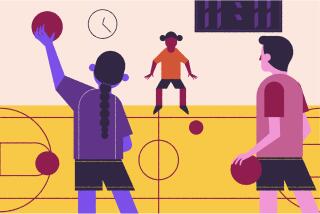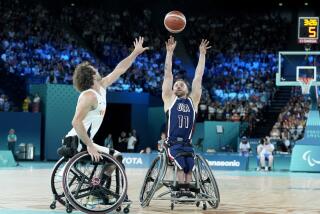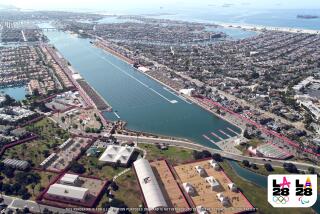End Game? : Once Ballyhooed as the Sport of the ‘80s, Racquetball May Meet Its Maker Before the ‘90s
Lee Keyte met his future wife on a racquetball court about five years ago. It wasn’t love at first serve. Keyte had never played the game when he challenged Jan Anderson to a match. She was an instructor with a deadly kill shot, but Keyte didn’t think a woman could beat him. So much for chauvinism. She spotted him 18 points and won, 21-18.
“I was humiliated,” he said. “She was out of my league.”
Keyte took up racquetball with vengeance--not romance--in mind. Three months after he was skunked, he got Anderson back on the court and beat her. From then on, their courtship, so to speak, began in earnest. They played racquetball, he said, “three hours a day, five days a week,” and were married within two years.
Nine months ago, the Tujunga couple became parents of a boy, but it didn’t take Jan Keyte long to get her swing back, or get back in swing. The Keytes continue to play racquetball together, she said, “and we’re still real competitive,” but now they have a family membership at the Laurel Canyon Fitness Centre.
Like a lot of people, Jan Keytes took up racquetball, she said, because it is a competitive sport that doesn’t require a lot of skill to be enjoyable, nor does it have the frustration level of tennis or the casual pace of golf, and it also provides an aerobic workout in a short amount of time.
When the Keytes met in the early 1980s, racquetball was at the peak of its popularity, the hottest recreational sport in America, “spearheading the whole fitness craze,” said Marty Hogan, the world’s top-ranked player.
Despite its phenomenal growth, however, racquetball has had problems in the last few years with participation declining, clubs going out of business and sales of equipment falling sharply. What happened to racquetball, say industry experts, is a case of too much too soon, the natural growing pains of a sport that is still in its infancy.
Racquetball began as an offspring of paddleball, which was invented in the late 1940s by a New Jersey tennis pro named Joseph Sobek, who has yet to become quite as famous as Abner Doubleday. The game was played on a one-wall court with a wooden paddle and a slow-moving ball. Efforts to play in four-wall handball courts were blocked by handball players who didn’t want their sweat-stained shrines violated by a mutant sport.
For a quarter-century, paddleball remained a very minor sport played primarily on the East Coast. But during the mid-’60s, in a flash of inspiration, Sobek cut the handle off a tennis racket and turned paddleball into racquetball. In 1969, Ektelon introduced the metal racket and a San Diego dentist named Bud Muehleisen used one to win the first national racquetball championship. Handball players could see the writing on their four walls: The age of racquetball had begun.
By 1976, according to a survey by the A. C. Nielsen Co., nearly 2.8 million Americans were playing racquetball. As the decade went by, Americans became more health and fitness conscious, and the racquetball boom was on, participation increasing to 10.6 million in 1979, according to Nielsen. Racquetball advocates saw the white light. To them, racquetball was the sport of the ‘80s. They predicted major television coverage, a rich professional tour and continued dramatic increases in participation.
But something happened to the sport of the ‘80s in the ‘80s. Although Nielsen counted 12 million participants in 1982, the boom was over. Retail sales of rackets declined from a high of $82.5 million in ’79 to $49.5 million in ‘82, according to a 1984 report by the National Sporting Goods Assn. The same report put the number of participants in ’84 at 9.4 million, a slide of about 13%.
The International Racquet Sports Assn. estimates that there are about 4,100 clubs with racquetball facilities in North America. But the trade association only recently began compiling figures and doesn’t have the data to compute the failure rate of racquetball clubs over the past several years.
In the Valley area, seven of 19 clubs have gone under since 1983, according to Lee Estes, assistant manager of Racquetball World in Canoga Park, and even the Valley Racquetball Assn. has folded. During the same period, no new clubs have been constructed, but the Sports Connection is reportedly planning to build a club in the Valley within the next two years.
What happened to the boom? “With a new sport, the faster the rise, the sharper the fall,” said Dan Casen of the National Sporting Goods Assn. “You also have to consider that the aerobics craze took a lot of people away from racquetball.”
Aerobics and body building, particularly the emphasis on Nautilus training, “had a definite impact” on racquetball, said Chuck Leve, editor of National Racquetball Magazine. “You have to understand that a lot of people do things that are ‘in.’ There was a time when racquetball was the thing to do. But the people who played racquetball because it was a fad are gone, and what’s left is a solid core of players.”
Estes, who has been involved in the business for the last eight years, blames poor management and ownership on the decline of clubs in the Valley area. But he also believes that the sport has stabilized and the clubs that survived did so because they diversified, offering other activities such as aerobics, Nautilus and swimming. And they changed their image. Rocky’s Racquet World, for instance, has become the Laurel Canyon Fitness Centre.
Another factor that put a halt to racquetball’s boom was the failure of the professional tour to generate a network television contract and build a large audience of potential players. The networks have shied away from the sport, industry experts say, for the same reasons that made hockey a weak TV attraction: The technical problems in following a small, fast-moving object have not been overcome. On the tube, you can’t see the ball.
“The lack of television exposure has held us back,” said Marty Hogan, who has dominated the professional tour for the past few years. “Without TV, there’s really no chance for the big time, but I’m optimistic that it’ll come. Cable has been pioneering the technical aspects of televising the sport, and I’ve been working with producers and directors to find a way to make racquetball more attractive for TV.”
The possibility of becoming a millionaire in sports like tennis and golf is incentive enough to play those games. Because it lacks a lucrative TV contract, racquetball can’t promise a pot of gold. Only “about a half-dozen pros are on the tour full-time,” Leve said. In 1985, 14 tournaments offered a total of $250,000 in prize money. Hogan was the tour’s top money winner with $60,000. He said he made another $500,000 from endorsements.
Paraphrasing “Saturday Night Live’s” Chico Esquela, Hogan said, “Racquetball been bery, bery good to me.”
The improved technology of racquetball equipment also may have had a negative impact on the growth of the game, said Phil Smith, former physical education director of the Jewish Community Centers Assn. in St. Louis. In the mid ‘60s, when Sobek’s sawed-off tennis racket made its debut, St. Louis and San Diego became the hotbeds of racquetball in this country, and the JCCA was the instigator in St. Louis. Smith even forced the handball players to coexist peacefully with the latecomers.
Smith has seen the game become faster because of whip-like graphite rackets and balls that rocket around the court like ricocheting bullets. to play racquetball well, more skill is required than ever before, Smith said, and the game isn’t as much fun to watch as it once was.
“It used to be a la-dee-da kind of game but now it’s just too fast,” he said. “You used to see the ball being hit 10 or 12 times in a rally, but now it’s serve and kill. The level of play has fallen off. There hasn’t been a continuation of development at a high level that we saw at the beginning and that we have in a sport like tennis.
“There was a time that I could see racquetball becoming the king. Youngsters and women had success hitting the ball. But for the uninitiated, racquetball just isn’t interesting anymore.”
Chuck Leve, however, sees a bright future for the sport.
“Maybe it’s no longer a trendy thing,” he said, “but all the reasons racquetball became popular are still valid.”
RACQUETBALL: WHERE TO PLAY IN THE VALLEY
MEMBERSHIP HOURLY NO. CLUB FEE COURT FEE COUR Oakridge Racquet Club $175 initiation None 10 2655 Erringer Road $420 annually (members only) Simi Valley (805) 522-5454 Sherman Oaks Health Spa $175 initiation None 8 5300 Coldwater Cyn. $144 annually (members only) Sherman Oaks (818) 505-0772 Mid Valley Athletic Club $345 initiation None 16 18420 Hart St. $720 annually (members only) Reseda (818) 705-6500 Sports Connection $60 initiation None 5 5251 Sepulveda Blvd. $480 annually (members only) Van Nuys (818) 788-1220 Supreme Court $300 annually None for members; 11 7030 Hayvenhurst Ave. $6.50 per person Van Nuys for non-members (818) 988-5500 Racquet Centre $35 annually $10 per court 11 10933 Ventura Blvd. N. Hollywood (818) 760-2303 Laurel Cyn. Fitness Center $300 annually None for members; 14 12111 Strathern St. non-members: $7 N. Hollywood per person (818) 768-5541 Aerobics & Nautilus Unltd. $192 annually None 6 10241 Balboa Blvd. Northridge (818) 993-3955 Westlake Sports House $15 initiation None 6 31425 Agoura Rd. $480 annually Westlake Village (818) 991-4500 Racquetball World $250 initiation None 24 22235 W. Sherman Way $600 annually Canoga Park (818) 884-5034 Le Club Sportif $300 annually None for members; 4 858 W. Jackman St. non-members: Lancaster $5 per person (805) 945-2618 Oakwood Fitness Center $344 annually None for members; 6 23670 W. Wiley Canyon Rd. non-members: Valencia $6 per person (805) 259-3737 Burbank YMCA $199 annually None 2 321 E. Magnolia Blvd. Burbank (818) 845-8551 Mid Valley YMCA $100 initiation None for members; 2 6901 Lennox Ave. $210 annually non-members: Van Nuys $4 per person (818) 989-3800 Holiday Spa $30 initiation None 3 13069 Victory Blvd. $360 annually North Hollywood (818) 506-4208
CLUB RESERVATIONS Oakridge Racquet Club Up to 3 days 2655 Erringer Road in advance Simi Valley (805) 522-5454 Sherman Oaks Health Spa Up to 1 week 5300 Coldwater Cyn. Sherman Oaks (818) 505-0772 Mid Valley Athletic Club Up to 3 days 18420 Hart St. in advance Reseda (818) 705-6500 Sports Connection Up to 3 days 5251 Sepulveda Blvd. in advance Van Nuys (818) 788-1220 Supreme Court Members: up to 7030 Hayvenhurst Ave. 2 days in advance Van Nuys non-members: (818) 988-5500 same day Racquet Centre Up to 2 weeks 10933 Ventura Blvd. in advance N. Hollywood (818) 760-2303 Laurel Cyn. Fitness Center Members: up to 12111 Strathern St. week in advance; N. Hollywood non-members: up (818) 768-5541 to day in advance Aerobics & Nautilus Unltd. Up to 2 days 10241 Balboa Blvd. in advance Northridge (818) 993-3955 Westlake Sports House Up to 1 day 31425 Agoura Rd. in advance Westlake Village (818) 991-4500 Racquetball World Up to 2 days 22235 W. Sherman Way in advance Canoga Park (818) 884-5034 Le Club Sportif Up to 2 days 858 W. Jackman St. in advance Lancaster (805) 945-2618 Oakwood Fitness Center Up to 1 week 23670 W. Wiley Canyon Rd. in advance Valencia (805) 259-3737 Burbank YMCA Up to 3 days 321 E. Magnolia Blvd. in advance Burbank (818) 845-8551 Mid Valley YMCA Up to 1 day 6901 Lennox Ave. in advance Van Nuys (818) 989-3800 Holiday Spa Up to 1 week 13069 Victory Blvd. in advance North Hollywood (818) 506-4208
More to Read
Go beyond the scoreboard
Get the latest on L.A.'s teams in the daily Sports Report newsletter.
You may occasionally receive promotional content from the Los Angeles Times.










